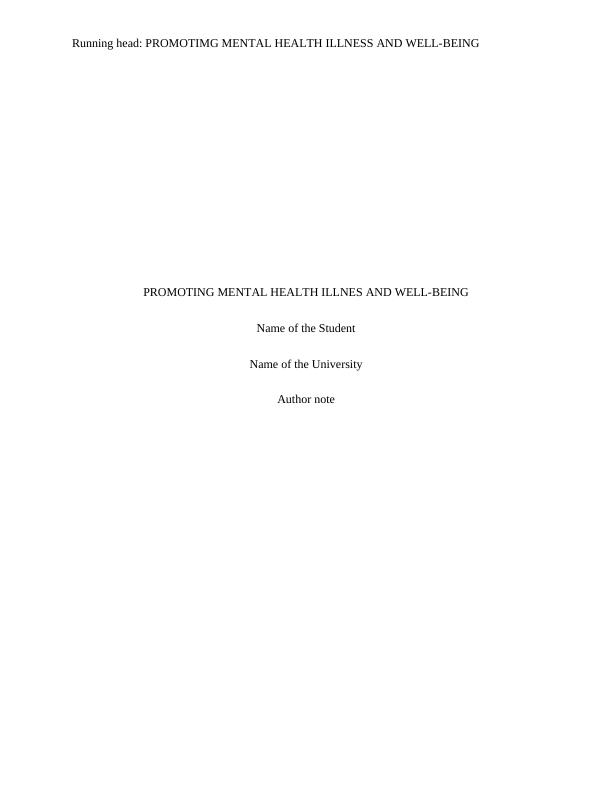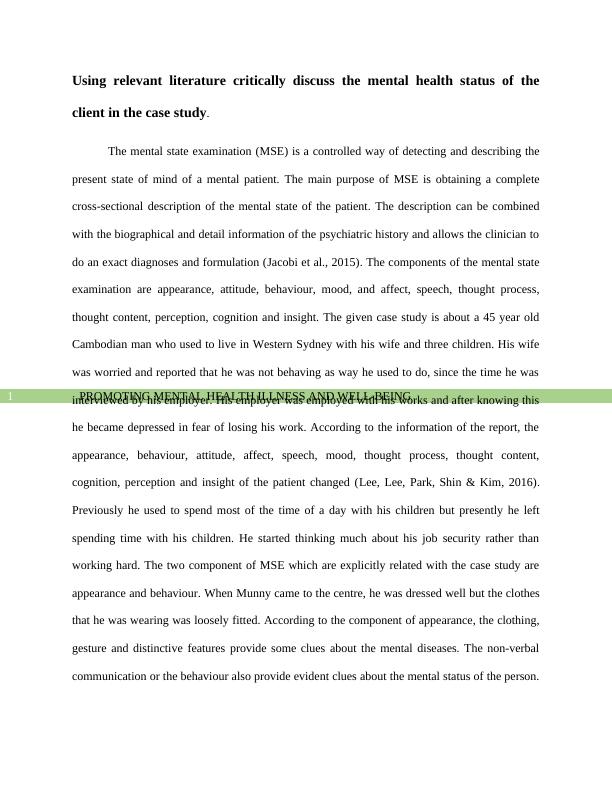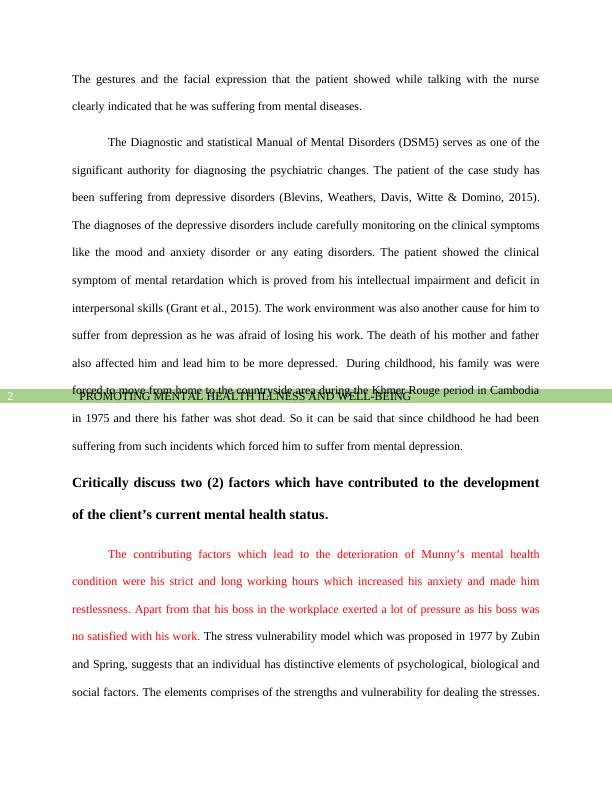Promoting Mental Health Illness and Well-Being
Added on 2023-01-03
10 Pages2707 Words82 Views
Running head: PROMOTIMG MENTAL HEALTH ILLNESS AND WELL-BEING
PROMOTING MENTAL HEALTH ILLNES AND WELL-BEING
Name of the Student
Name of the University
Author note
PROMOTING MENTAL HEALTH ILLNES AND WELL-BEING
Name of the Student
Name of the University
Author note

PROMOTING MENTAL HEALTH ILLNESS AND WELL-BEING1
Using relevant literature critically discuss the mental health status of the
client in the case study.
The mental state examination (MSE) is a controlled way of detecting and describing the
present state of mind of a mental patient. The main purpose of MSE is obtaining a complete
cross-sectional description of the mental state of the patient. The description can be combined
with the biographical and detail information of the psychiatric history and allows the clinician to
do an exact diagnoses and formulation (Jacobi et al., 2015). The components of the mental state
examination are appearance, attitude, behaviour, mood, and affect, speech, thought process,
thought content, perception, cognition and insight. The given case study is about a 45 year old
Cambodian man who used to live in Western Sydney with his wife and three children. His wife
was worried and reported that he was not behaving as way he used to do, since the time he was
interviewed by his employer. His employer was employed with his works and after knowing this
he became depressed in fear of losing his work. According to the information of the report, the
appearance, behaviour, attitude, affect, speech, mood, thought process, thought content,
cognition, perception and insight of the patient changed (Lee, Lee, Park, Shin & Kim, 2016).
Previously he used to spend most of the time of a day with his children but presently he left
spending time with his children. He started thinking much about his job security rather than
working hard. The two component of MSE which are explicitly related with the case study are
appearance and behaviour. When Munny came to the centre, he was dressed well but the clothes
that he was wearing was loosely fitted. According to the component of appearance, the clothing,
gesture and distinctive features provide some clues about the mental diseases. The non-verbal
communication or the behaviour also provide evident clues about the mental status of the person.
Using relevant literature critically discuss the mental health status of the
client in the case study.
The mental state examination (MSE) is a controlled way of detecting and describing the
present state of mind of a mental patient. The main purpose of MSE is obtaining a complete
cross-sectional description of the mental state of the patient. The description can be combined
with the biographical and detail information of the psychiatric history and allows the clinician to
do an exact diagnoses and formulation (Jacobi et al., 2015). The components of the mental state
examination are appearance, attitude, behaviour, mood, and affect, speech, thought process,
thought content, perception, cognition and insight. The given case study is about a 45 year old
Cambodian man who used to live in Western Sydney with his wife and three children. His wife
was worried and reported that he was not behaving as way he used to do, since the time he was
interviewed by his employer. His employer was employed with his works and after knowing this
he became depressed in fear of losing his work. According to the information of the report, the
appearance, behaviour, attitude, affect, speech, mood, thought process, thought content,
cognition, perception and insight of the patient changed (Lee, Lee, Park, Shin & Kim, 2016).
Previously he used to spend most of the time of a day with his children but presently he left
spending time with his children. He started thinking much about his job security rather than
working hard. The two component of MSE which are explicitly related with the case study are
appearance and behaviour. When Munny came to the centre, he was dressed well but the clothes
that he was wearing was loosely fitted. According to the component of appearance, the clothing,
gesture and distinctive features provide some clues about the mental diseases. The non-verbal
communication or the behaviour also provide evident clues about the mental status of the person.

PROMOTING MENTAL HEALTH ILLNESS AND WELL-BEING2
The gestures and the facial expression that the patient showed while talking with the nurse
clearly indicated that he was suffering from mental diseases.
The Diagnostic and statistical Manual of Mental Disorders (DSM5) serves as one of the
significant authority for diagnosing the psychiatric changes. The patient of the case study has
been suffering from depressive disorders (Blevins, Weathers, Davis, Witte & Domino, 2015).
The diagnoses of the depressive disorders include carefully monitoring on the clinical symptoms
like the mood and anxiety disorder or any eating disorders. The patient showed the clinical
symptom of mental retardation which is proved from his intellectual impairment and deficit in
interpersonal skills (Grant et al., 2015). The work environment was also another cause for him to
suffer from depression as he was afraid of losing his work. The death of his mother and father
also affected him and lead him to be more depressed. During childhood, his family was were
forced to move from home to the countryside area during the Khmer Rouge period in Cambodia
in 1975 and there his father was shot dead. So it can be said that since childhood he had been
suffering from such incidents which forced him to suffer from mental depression.
Critically discuss two (2) factors which have contributed to the development
of the client’s current mental health status.
The contributing factors which lead to the deterioration of Munny’s mental health
condition were his strict and long working hours which increased his anxiety and made him
restlessness. Apart from that his boss in the workplace exerted a lot of pressure as his boss was
no satisfied with his work. The stress vulnerability model which was proposed in 1977 by Zubin
and Spring, suggests that an individual has distinctive elements of psychological, biological and
social factors. The elements comprises of the strengths and vulnerability for dealing the stresses.
The gestures and the facial expression that the patient showed while talking with the nurse
clearly indicated that he was suffering from mental diseases.
The Diagnostic and statistical Manual of Mental Disorders (DSM5) serves as one of the
significant authority for diagnosing the psychiatric changes. The patient of the case study has
been suffering from depressive disorders (Blevins, Weathers, Davis, Witte & Domino, 2015).
The diagnoses of the depressive disorders include carefully monitoring on the clinical symptoms
like the mood and anxiety disorder or any eating disorders. The patient showed the clinical
symptom of mental retardation which is proved from his intellectual impairment and deficit in
interpersonal skills (Grant et al., 2015). The work environment was also another cause for him to
suffer from depression as he was afraid of losing his work. The death of his mother and father
also affected him and lead him to be more depressed. During childhood, his family was were
forced to move from home to the countryside area during the Khmer Rouge period in Cambodia
in 1975 and there his father was shot dead. So it can be said that since childhood he had been
suffering from such incidents which forced him to suffer from mental depression.
Critically discuss two (2) factors which have contributed to the development
of the client’s current mental health status.
The contributing factors which lead to the deterioration of Munny’s mental health
condition were his strict and long working hours which increased his anxiety and made him
restlessness. Apart from that his boss in the workplace exerted a lot of pressure as his boss was
no satisfied with his work. The stress vulnerability model which was proposed in 1977 by Zubin
and Spring, suggests that an individual has distinctive elements of psychological, biological and
social factors. The elements comprises of the strengths and vulnerability for dealing the stresses.

End of preview
Want to access all the pages? Upload your documents or become a member.
Related Documents
Promoting Mental Health and Wellbeinglg...
|8
|2285
|193
Mental Health Nursinglg...
|8
|2271
|274
Case Study 2: Munny Kaewlg...
|8
|2035
|369
Analysis of a Case Study on Mental Health Nursinglg...
|9
|2460
|304
Case study Mental Health Assessmentlg...
|6
|2082
|416
Promotion of Mental Health and Wellbeinglg...
|8
|2228
|275